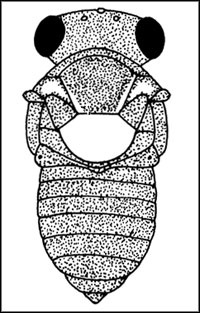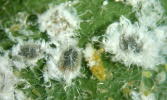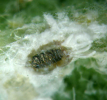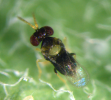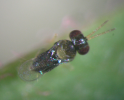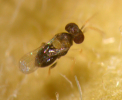 |
||||
Scientific nameEncarsia guadeloupae Viggiani (1987)
Taxonomic positionHymenoptera: Chalcidoidea: Aphelinidae
DiagnosisHead and body predominantly brown, scutellum yellow, apical portion of mesoscutum and notaular areas much lighter, yellowish brown. Antenna yellow, radicle and scape (except at apex) brownish. Fore wing hyaline with slightly infuscate band behind basal half of marginal vein. Legs yellow except hind coxa and femur brown. Fore and hind tarsi five-segmented, middle tarsi four-segmented. Detailed description available at http://www.ento.csiro.au/science/encarsia/gua_ss.htm.
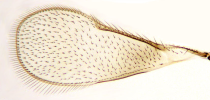 Fore wing venation in E. guadeloupae
Fore wing venation in E. guadeloupaeEncarsia dispersa Polaszek, the other aphelinid parasitoid of spiralling whitefly accidentally introduced in India, can be easily distinguished from E. guadeloupae by its completely yellow to orange body. Further, apparently due to competitive displacement by E. guadeloupae, E. dispersa is no longer seen in peninsular India, where it had been recorded earlier (see Remarks).
ImagesDistributionIndia: Karnataka; Kerala; Tamil Nadu; Maharashtra. Pacific Islands, Micronesia, Papua New Guinea. Accidentally / deliberately introduced along with the host in India and several other countries of the world.
HostsKnown to parasitise only A. dispersus so far in India. Also recorded on Bemisia tabaci (Gennadius) and Trialeurodes vaporariorum (Westwood) in other countries.
RemarksEncarsia guadeloupae was first reported from Minicoy Island in the Lakshadweeps in 1999 and later deliberately introduced into the mainland and established there. It is likely these parasitoids migrated from the Maldives into Minicoy and other islands of the Lakshadweeps and later, assisted by the intentional release and colonization, spread to other areas of peninsular India. The parasitoid, in conjunction with several indigenous predators, particularly Axinoscymnus puttarudriahi Kapur & Munshi and Cybocephalus spp., has successfully kept the whitefly population in check in most parts of peninsular India.
Another species, Encarsia dispersa Polaszek, was also accidentally introduced into India. This species has been variously referred to as Encarsia sp. (a species closely related to Encarsia haitiensis Dozier and E. meritoria), E. sp. nr. haitiensis and E. sp. nr. meritoria in the literature (Ramani et al., 2002). It was first recorded from Kerala in 1998, nearly five years after the pest was reported from the same state. This species was later recorded from Bangalore and other areas in peninsular India. It was introduced in the Indian mainland before E. guadeloupae, apparently along with the host. This species has been only recently described as Encarsia dispersa (Polaszek et al., 2004), based on extensive molecular taxonomic studies on the E. meritoria-group of species. In an apparent case of competitive displacement, Encarsia guadeloupae has nearly completely displaced E. dispersa in most of the places in India where it was colonised and the latter has not been collected in the recent past in peninsular India. References
|
||||
